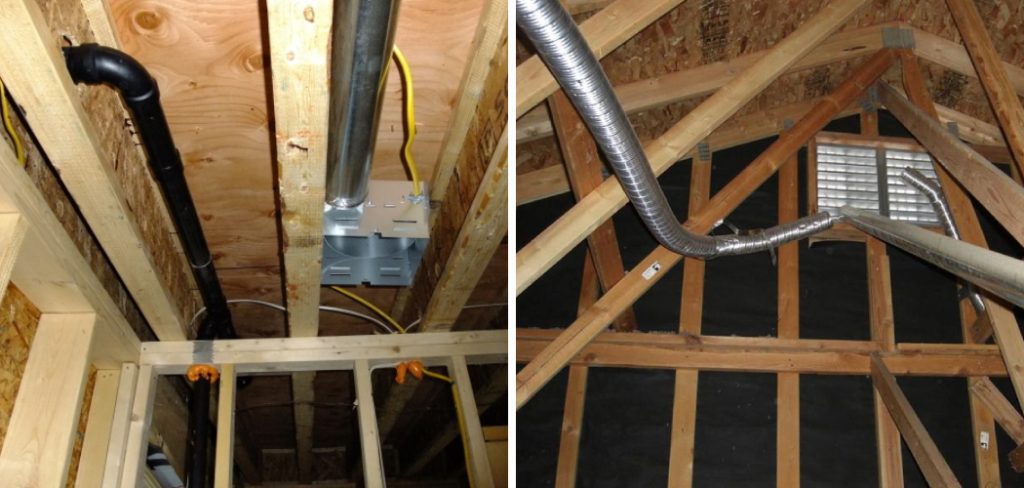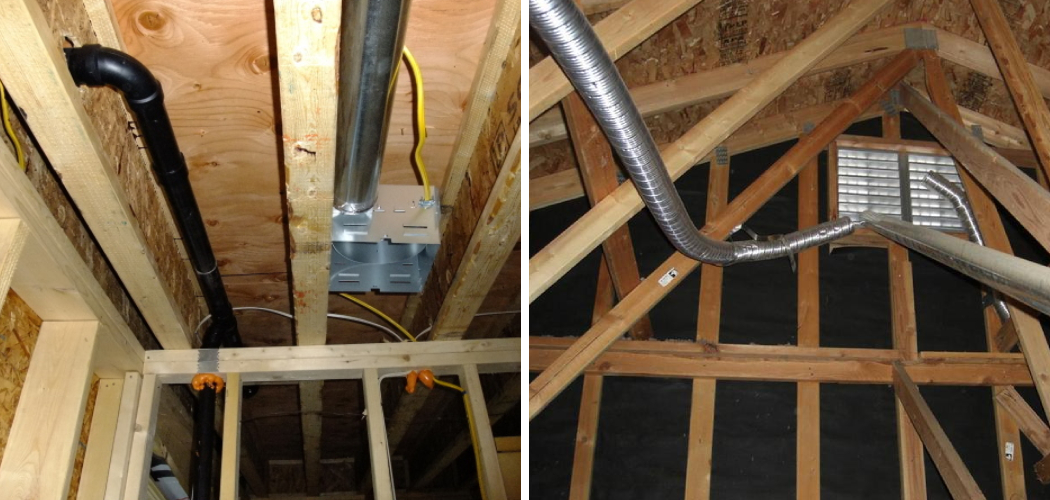Venting a bathroom fan through the soffit is one of the most efficient ways to keep moisture and humidity levels within your home under control. Aside from providing much-needed ventilation, this method of venting out hot air can help extend the life of both your bathroom fan and the items located in your walls due to decreased temperatures generated by direct airflow through surrounding areas.
In this blog post, we’ll walk you through exactly how to vent a bathroom fan through soffit! Venting a bathroom fan through the soffit can be an effective way to improve airflow in your home and reduce humidity levels. This type of ventilation is especially important for homeowners who want to keep their bathrooms safe, dry, and comfortable.

By learning more about how to vent a bathroom fan through the soffit, you’ll be taking steps toward maintaining good indoor air quality throughout your house. Here we will discuss some of the key benefits of making this simple upgrade, as well as provide helpful tips on choosing and installing a proper ventilation system.
Why May You Want to Vent a Bathroom Fan Through Soffit?
1. To Get Much-needed Ventilation
One of the reasons you may want to vent a bathroom fan through the soffit is to get much-needed ventilation. Many bathrooms are not well-ventilated, which can lead to problems with humidity and dampness that can cause mold or mildew growth or staining on the walls and ceilings.
By venting the fan through the soffit, you’ll be able to increase the amount of air circulation in your bathroom, which can help prevent these moisture issues.
2. To Keep the Air Cleaner
In addition to helping with ventilation, venting a bathroom fan through the soffit can also help keep the air cleaner. By drawing out excess airborne particles from the bathroom, like dirt, dust, and other allergy-causing debris, the fan can help keep the air in your bathroom free of pollutants. This can be especially beneficial if you have allergies or asthma that could be aggravated by airborne particles.

3. To Improve Aesthetics
Finally, venting a bathroom fan through the soffit can also help improve the aesthetics of your bathroom. By installing the fan in the soffit, you’ll be able to keep it out of sight and blend it in with your home’s exterior. This can help give your bathroom a more flowline look that won’t detract from its overall design.
Overall, venting a bathroom fan through the soffit can provide many benefits. From improving ventilation and air quality to enhancing the aesthetics of your bathroom, this is a great way to keep your bathroom comfortable and looking its best. With careful planning, you can ensure that your fan is installed correctly and safely.
How to Vent a Bathroom Fan Through Soffit in 6 Easy Steps
Step 1: Gather All The Materials
The very first step is to gather the materials that you need. This includes a soffit, vent cover, drill bits, and screws. Make sure that all of these items are in good condition and appropriate for the job at hand.
Step 2: Mark Where The Vent Will Go
The next step is to mark where your vent will go with a pencil. Measure and mark the outline of the vent cover that you have chosen, making sure that it is centered in the desired spot.
Step 3: Drill Holes
Now, use a drill to create two or three holes along each side of your marked outline depending on how many screws are required for your particular vent cover. Use a bit that is the same size as your screws so they fit properly.
Step 4: Place The Vent Cover
Place the vent cover into the holes and secure it with screws. Make sure that all of them are tightened securely. This can be done using a screwdriver or electric drill. But you have to be careful while doing this.

Step 5: Install The Soffit
Next, install the soffit over the vent cover by attaching it to your home’s siding with nails or screws. Make sure that they are secure and not loose. Also, check that the soffit is level and properly aligned.
Step 6: Connect The Vent
The last step is to connect the vent to your bathroom fan. This can be done with duct tape or a flexible tube connector. Make sure that it is firmly connected and that there are no gaps between the ends of the connection. And you’re done!
Venting a bathroom fan through the soffit is a great way to improve the efficiency of your bathroom and make it more comfortable. By following these six easy steps, you can vent your fan through the soffit with no problems. Good luck, and happy venting!
Some Additional Tips to Vent a Bathroom Fan Through Soffit
1. Avoid Using a Too-Powerful Fan
One of the most important tips when venting a bathroom fan through a soffit is to avoid using a fan that’s too powerful. An overly-powerful fan may exhaust air more quickly than the soffit can supply it, resulting in negative pressure that pulls dirty air back into the house.
2. Create an Air Tight Seal
Another key tip when venting a bathroom fan through the soffit is to make sure the seal between the fan and the soffit is airtight. This can be done by using foam weatherstripping or caulk around the edges of the fan to ensure that no air leaks out.
3. Consider Installing an Inline Fan
Installing an inline fan is also a great option when venting a bathroom fan through the soffit. An inline fan is installed directly in the ductwork, allowing it to run more efficiently and quietly than other types of fans.

4. Use Proper Ductwork
Finally, make sure all ductwork used for venting the bathroom fan is properly sized. The ductwork should be as large as possible and properly insulated to ensure the maximum amount of air is expelled from the fan.
By following these tips, you can easily and effectively vent a bathroom fan through your soffit. Doing so will help keep your home comfortable and safe while also reducing energy costs in the long run.
Frequently Asked Questions
What Precautions Should I Take When Venting a Bathroom Fan Through Soffit?
When venting a bathroom fan through the soffit, there are several precautions that should be taken to ensure proper ventilation and airflow. Make sure the duct from the fan is insulated with an approved product. This will help keep the warm air from escaping in winter months and help cool the air in the summer. Additionally, ensure that the fan is installed correctly, with all joints securely sealed to avoid any air leakage.
What Tools Do I Need to Vent a Bathroom Fan Through Soffit?
When venting a bathroom fan through the soffit, you will need several basic tools such as a drill, saw, measuring tape, screws, and ducting materials as well as more specialized tools like an exhaust fan installation kit. Additionally, you will need to wear protective gear such as dust masks and gloves when installing the fan.
What Are the Benefits of Venting a Bathroom Fan Through Soffit?
Venting a bathroom fan through the soffit is a great way to ensure proper ventilation and air flow in the bathroom. This method helps to keep moisture from accumulating and causing mold or mildew buildup, which can be damaging to the walls, ceiling, and other surfaces in the room.
Additionally, it helps reduce steam accumulation which can cause damage to mirrors and other fixtures in the bathroom. It also helps to keep odors at bay, improving the overall air quality in your home.

Can I Vent a Bathroom Fan Through the Roof?
Yes, you can also vent a bathroom fan through the roof. However, this method tends to be more complex and costly as it requires specialized tools and materials as well as skilled labor. Additionally, there is a risk of water leakage when venting through the roof which may need to be addressed with additional waterproofing measures.
Overall, venting a bathroom fan through the soffit is an effective way to ensure proper ventilation and airflow in the bathroom without compromising aesthetics. With the right tools and precautions, you can easily install this system yourself and enjoy improved air quality.
Conclusion
Overall, learning how to vent a bathroom fan through soffit is a simple and straightforward process. With the right tools, supplies, and knowledge at hand, you’re well on your way to having an effective ventilation system. A successful job ensures that air circulation is constantly moving through the home to keep it both comfortable and safe from mildew or mold buildup.
If done correctly, you now have a fan that efficiently clears the air while keeping noise levels relatively low.
Always remember to inspect your fan before and after installation to ensure all of its components are in working order. Also, if ever in doubt about any part of the job, contact a certified contractor for help. Venting a bathroom fan through the soffit doesn’t have to be complicated – following these steps will guarantee an efficient exhaust system for years to come!

